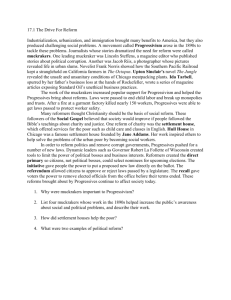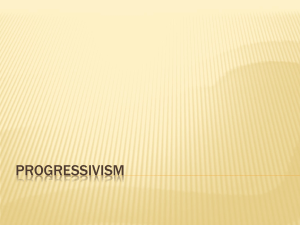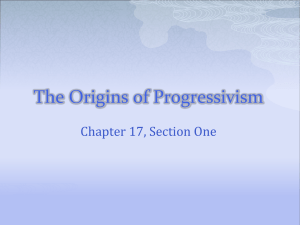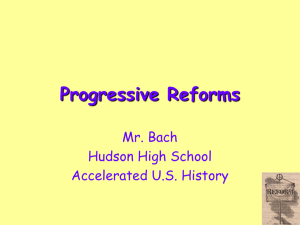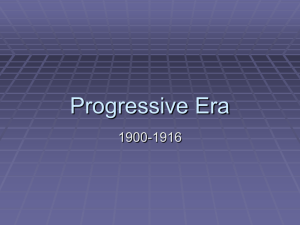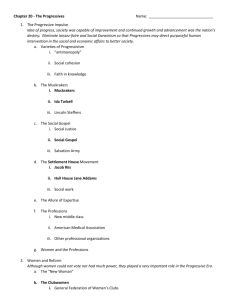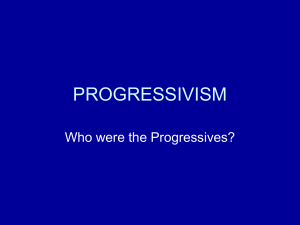Reformers and Progressives - Waverly
advertisement
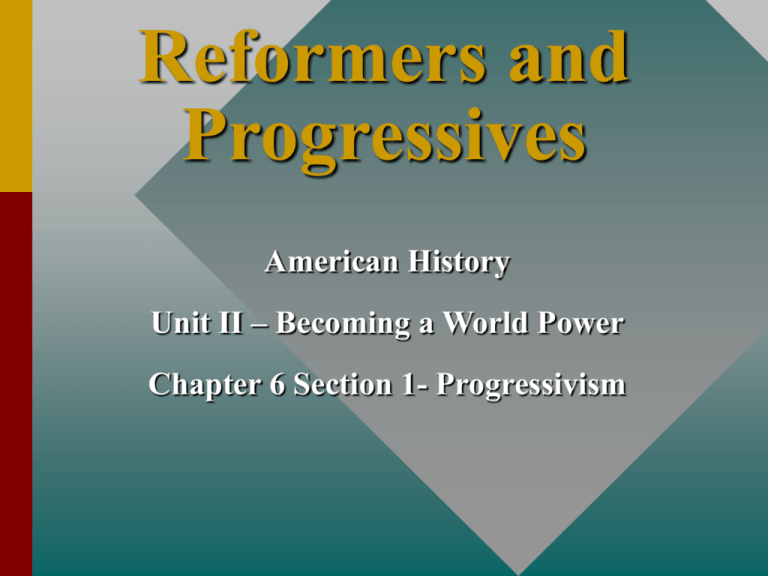
Reformers and Progressives American History Unit II – Becoming a World Power Chapter 6 Section 1- Progressivism Progressivism The Main Idea Progressives focused on three areas of reform: easing the suffering of the urban poor, improving unfair and dangerous working conditions, and reforming government at the national, state, and local levels. Reading Focus • What issues did Progressives focus on, and what helped energize their causes? • How did Progressives try to reform society? • How did Progressives fight to reform the workplace? • How did Progressives reform government at the national, state, and local levels? Muckrakers Name applied to American journalists, novelists, and critics who in the first decade of the 20th cent. attempted to expose the abuses of business and the corruption in politics. The term derives from the word muckrake used by President Theodore Roosevelt in a speech in 1906, in which he agreed with many of the charges of the muckrakers but asserted that some of their methods were sensational and irresponsible. The muckraking movement lost support in about 1912. Historians agree that if it had not been for the revelations of the muckrakers the Progressive movement would not have received the popular support needed for effective reform. Who were the reformers? What did they want? Mostly middle class people (Roosevelt called them Muckrakers) concerned with social issues of the times. Issues such as; immigrants - oldcomers and newcomers city life- poor and needy, and prohibition crime and corruption strikes, Workman’s compensation, minimum wage Political bosses city/state governments- direct democracy, tax laws Giant business corporations Women’s Suffrage Child Labor Progressivism and Its Champions • Industrialization helped many but also created dangerous working environments and unhealthy living conditions for the urban poor. • Progressivism, a wide-ranging reform movement targeting these problems, began in the late 19th century. • Journalists called muckrakers and urban photographers exposed people to the plight of the unfortunate in hopes of sparking reform. Jacob Riis • Danish immigrant who faced New York poverty • Exposed the slums through magazines, photographs, and a best-selling book • His fame helped spark city reforms. Ida Tarbell • Exposed the corrupt Standard Oil Company and its owner, John D. Rockefeller • Appealed to middle class scared by large business power Lincoln Steffens • Shame of the Cities (1904) exposed corrupt city governments Frank Norris • Exposed railroad monopolies in a 1901 novel Muckrakers Ida Tarbell Lincoln Steffen Upton Sinclair Jacob Riis • Miss Ida Tarbell had been at work for years on her history of the Standard Oil Company, and it began to run in McClure's in November 1902. • Lincoln Steffen's first novel on municipal corruption, "Tweed Days in St. Louis" appeared in McClure's Oct 1902. • Henry Demerest Lloyd's Wealth Against Commonwealth, published in 1894, attacked the Standard Oil Company. • How the Other Half Lives, published in 1890 by • John Spargo, an Englishman, published The Bitter Cry of the Children, an account of young kids at work in sweatshops. • Perhaps the most famous Muckraking novel, The Jungle by Upton Sinclair, exposed the horrors of the Chicago meat-packing plants and the Jacob Riis, exposed life in New York's slums. immigrants who were worked to death in them. Reforming Society • Growing cities couldn’t provide people necessary services like garbage collection, safe housing, and police and fire protection. • Reformers, many of whom were women like activist Lillian Wald, saw this as an opportunity to expand public health services. • Progressives scored an early victory in New York State with the passage of the Tenement Act of 1901, which forced landlords to install lighting in public hallways and to provide at least one toilet for every two families, which helped outhouses become obsolete in New York slums. • These simple steps helped impoverished New Yorkers, and within 15 years the death rate in New York dropped dramatically. • Reformers in other states used New York law as a model for their own proposals. Fighting for Civil Rights Progressives fought prejudice in society by forming various reform groups. NAACP • National Association for the Advancement of Colored People • Formed in 1909 by a multiracial group of activists to fight for the rights of African Americans • 1913: Protested the official introduction of segregation in federal government • 1915: Protested the D. W. Griffith film Birth of a Nation because of hostile African American stereotypes, which led to the film’s banning in eight states ADL • Anti-Defamation League • Formed by Sigmund Livingston, a Jewish man in Chicago, in 1913 • Fought anti-Semitism, or prejudice against Jews, which was common in America • Fought to stop negative stereotypes of Jews in media • The publisher of the New York Times was a member and helped stop negative references to Jews Reforming the Workplace • By the late 19th century, labor unions fought for adult male workers but didn’t advocate enough for women and children. • In 1893, Florence Kelley helped push the Illinois legislature to prohibit child labor and to limit women’s working hours. • In 1904, Kelley helped organize the National Child Labor Committee, which wanted state legislatures to ban child labor. • By 1912, nearly 40 states passed child-labor laws, but states didn’t strictly enforce the laws and many children still worked. • Progressives, mounting state campaigns to limit workdays for women, were successful in states including Oregon and Utah. • But since most workers were still underpaid and living in poverty, an alliance of labor unions and progressives fought for a minimum wage, which Congress didn’t adopt until 1938. • Businesses fought labor laws in the Supreme Court, which ruled on several cases in the early 1900s concerning workday length. Labor Law in the Supreme Court Lochner v. New York • 1905: The Court refused to uphold a law limiting bakers to a 10-hour workday. • The Court said it denied workers the right to make contracts with their employers. • This was a blow to progressives, as the Court sided with business owners. Muller v. Oregon • The Court upheld a state law establishing a 10hour workday for women in laundries and factories. • Louis D. Brandeis was the attorney for the state of Oregon and a future Supreme Court Justice. • He argued that evidence proved long hours harmed women’s health. Bunting v. Oregon • Brandeis’ case, or the Brandeis brief, as his defense was called, became a model for similar cases. • Using the tactics of its case for women, in Bunting v. Oregon the state led the Court to uphold a law that extended the protection of a 10hour workday to men working in mills and factories. The Triangle Shirtwaist Company Fire In 1911, a gruesome disaster in New York inspired progressives to fight for safety in the workplace. • About 500 women worked for the Triangle Shirtwaist Company, a high-rise building sweatshop that made women’s blouses. • Just as they were ending their six-day workweek, a small fire broke out, which quickly spread to three floors. • Escape was nearly impossible, as doors were locked to prevent theft, the flimsy fire escape broke under pressure, and the fire was too high for fire truck ladders to reach. • More than 140 women and men died in the fire, marking a turning point for labor and reform movements. • With the efforts of Union organizer Rose Schneiderman and others, New York State passed the toughest fire-safety laws in the nation, as well as factory inspection and sanitation laws. • New York laws became a model for workplace safety nationwide. The Unions ILGWU • In 1900, the International Ladies’ Garment Workers Union organized unskilled workers. • In 1909, the ILGWU called a general strike known as the Uprising of 20,000. • Strikers won a shorter workweek and higher wages and attracted thousands of workers to the union. IWW • In 1905, the Industrial Workers of the World formed to oppose capitalism, organizing unskilled workers that the American Federation of Labor ignored. • Under William “Big Bill” Haywood, the IWW, known as Wobblies, used traditional tactics like strikes and boycotts but also engaged in radical tactics like industrial sabotage. • By 1912, the IWW led 23,000 textile workers to strike in Massachusetts to protest pay cuts, which ended successfully after six weeks. • However, several IWW strikes were failures, and, fearing the IWW’s revolutionary goals, the government cracked down on the organization, causing dispute among its leaders and leading to its decline a few years later. Reforming Government City Government • Reforming government meant winning control of it: – Tom Johnson of Cleveland was a successful reform mayor who set new rules for police, released debtors from prison, and supported a fairer tax system. • Progressives promoted new government structures: – Texas set up a five-member committee to govern Galveston after a hurricane, and by 1918, 500 cities adopted this plan. – The city manager model had a professional administrator, not a politician, manage the government. State Government • Progressive governor Robert La Follette created the Wisconsin Ideas, which wanted: – Direct primary elections; limited campaign spending – Commissions to regulate railroads and oversee transportation, civil service, and taxation • Other governors pushed for reform, but some were corrupt: – New York’s Charles Evan Hughes regulated insurance companies. – Mississippi’s James Vardaman exploited prejudice to gain power. Election Reforms • Progressives wanted fairer elections and to make politicians more accountable to voters. – Proposed a direct primary, or an election in which voters choose candidates to run in a general election, which most states adopted. – Backed the Seventeenth Amendment, which gave voters, not state legislatures, the power to elect their U.S. senators. • Some measures Progressives fought for include Direct primary: voters select a party’s candidate for public office 17th Amendment: voters elect their senators directly secret ballot: people vote privately without fear of coercion initiative: allows citizens to propose new laws referendum: allows citizens to vote on a proposed or existing law recall: allows voters to remove an elected official from office Reforming Government • City Government reforms – New rules for police, releasing debtors from prison and a fairer tax system. – 5 member commission system – Council-manager model • State government reforms • Election reforms – Seventeenth Amendment – Initiative, referendum and recall. National Association for the Advancement of Colored People 1909 On February 12th The National Association for the Advancement of Colored People was founded by a multiracial group of activists, who answered "The Call." They initially called themselves the National Negro Committee. Organized to end discrimination and to prevent violence against blacks, especially lynching. FOUNDERS: Ida Wells-Barnett, W.E.B. DuBois, Henry Moscowitz, Mary White Ovington, Oswald Garrison Villiard, William English Walling and led the "Call" to renew the struggle for civil and political liberty. N.A.A.C.P. • The NAACP started its own magazine, Crisis in November, 1910 • NAACP campaigned, especially in the Supreme Court against lynching, segregation and racial discrimination in housing, education, employment, voting and transportation. • NAACP also fought for Women’s Suffrage. City Government Commission Plan Replaced the mayor and council with a small board of commissioners, each elected at large and each responsible for a single area of municipal administration. Under the new plan voters could easily identify and punish those responsible for shortcomings in city services. City Government City Manager scheme Under this plan an elected city council determined basic policy and appointed a professional, nonpartisan city manager who was in charge of the day-to-day operation of the municipality. Worked well in small cities. Critics of corruption urged adoption of nonpartisan elections, new methods of municipal accounting, a civil service system for city employees, and state constitutional amendments to halt state legislative interference in municipal affairs. Child Labor The rise of child labor in the United States began in the late seventeen and early eighteen hundreds. Industrialization was a strong force in increasing the number of working children. Sadie Pfeifer, 48 inches high. Has worked half a year. By nineteen hundred more than two million U.S. children worked. Children worked in factories, mines, fields and in the streets. They picked cotton, shined shoes, sold newspapers, canned fish, made clothes and wove fabric. Children were forced into this situation in order to help support their families. Child Labor Working conditions were often horrendous. Children would work twelve hours a day, six days a week throughout the year. The hours were long, the pay was low and the children were exhausted and hungry. Breaker Boys" were used in the anthracite coal mines to separate slate rock from the coal after it had been brought out of the shaft. They often worked 14 to 16 hours a day. Factory children were kept inside all day long, children who worked the fields spent long, hot days in the sun or went barefoot in mud and rain. These young workers could not attend school and rarely knew how to read or write Child Labor Children in the United States continued to work under deplorable conditions until well into the midtwentieth century. In the early nineteen hundreds, reformers began working to raise awareness about the dangers of child labor and tried to establish laws regulating the practice. In 1904, the National Child Labor Committee was formed. Throughout the nineteen hundreds, Congress and the Supreme Court were at odds over child labor regulation. 1938- the Fair Labor Standards Act was passed and children were freed from the bondage of dangerous work Lewis Hines In 1908 the National Child Labor Committee employed Lewis Hine as their staff investigator and photographer. Hine traveled the country taking pictures of children working in factories. Hine also lectured on the subject and once told one audience: "Perhaps you are weary of child labor pictures. Well, so are the rest of us, but we propose to make you and the whole country so sick and tired of the whole business that when the time for action comes, child labor pictures will be records of the past." Congress Attempts to Control Child Labor In 1916 Congress made its first effort to control child labor by passing the Keating-Owen Act. The legislation forbade the transportation among states of products of factories, shops or canneries employing children under 14 years of age, of mines employing children under 16 years of age, and the products of any of these employing children under 16 who worked at night or more than eight hours a day. In 1918 the Supreme Court ruled that the Keating-Owen Act was unconstitutional. After the Supreme Court ruled that the Keating-Owen Act was unconstitutional, Congress passed a Second Child Labor Law. This levied a tax of ten per cent on the net profits of factories employing children under the age of 14, and of mines and quarries employing children under the age of 16. This legislation was declared unconstitutional as a result of the Drexel Furniture Company case in 1922. Fair Labor Standards Act June, 1938, that Congress passed the Fair Labor Standards Act. The main objective of the act was to eliminate "labor conditions detrimental to the maintenance of the minimum standards of living necessary for health, efficiency and well-being of workers". This included the prohibition of child labor in all industries engaged in producing goods in inter-state commerce. It set the minimum age at 14 for employment outside of school hours in nonmanufacturing jobs, at 16 for employment during school hours, and 18 for hazardous occupations. Direct Democracy Secret Ballot Direct Primary- People select the candidates INITIATIVE: The people may initiate(propose) by 5-8% petition of voters a bill to a legislature. REFERENDUM: The people may use referendum (popular ballot) to enact, approve or reject acts of the legislature. RECALL: All elected public officials in the State, except judicial officers, are subject to recall (by petition) by the voters of the State and forced to stand for re-election at any time. 17th Amendment: Direct Election of Senators. The Senate of the United States shall be composed of two Senators from each State, elected by the people thereof, for six years; and each Senator shall have one vote Progressive Movement • The Progressive Movement was an effort to cure many of the ills of American society that had developed during the great spurt of industrial growth in the last quarter of the 19th century. The frontier had been tamed, great cities and businesses developed and an overseas empire established, but not all citizens shared in the new wealth, prestige and optimism. • Progressivism was rooted in the belief that man was capable of improving the lot of all within society. Progressivism also was full of strong political overtones and rejected the church as the driving force for change. Supporters of the movement were found in both major political parties, Democrat and Republican. • Specific goals included: – Remove corruption and undue influence from government – Conservation – Include more people more directly in the political process. – Government must play a role to solve social problems and establish fairness in economic matters. – Race- Blacks and Native Americans – Child Labor, Workers- young and old, workers compensation, – Political Reform- Direct Election, political reform, – Anti- monopoly reform. Progressive Movement • The efforts and successes: • – Interstate Commerce Act (1887) and the Sherman Antitrust Act (1890). – A minority supported socialism with government ownership of the means of production. – conservation movement – railroad legislation – food and drug laws. – elect senators – prohibition – suffrage to women. – Workers compensation, civil service, and minimum wage – efforts to place limitations on child labor were routinely thwarted by the courts. – The needs of blacks and Native Americans were poorly served by the Progressives. – Secret Ballot, Direct Election, direct primary and initiative, referendum and recall Robert LaFollette- Leader in reform measures and the candidate of the reform element of his party for the nomination for governor in 1896 and 1898: in 1900 unanimously nominated for Governor of Wisconsin and elected by the largest plurality ever given a candidate for that office.
